BPK 110 CH 7 PROTEINS
1/57
There's no tags or description
Looks like no tags are added yet.
Name | Mastery | Learn | Test | Matching | Spaced |
|---|
No study sessions yet.
58 Terms
Proteins are:
Folded amino acid chains
Amino acids (AAs) have three main groups:
– A nitrogen-containing amine group
– A carboxylic acid
– A side chain (Rx)
There are __ amino acids, that make up….
21, proteins
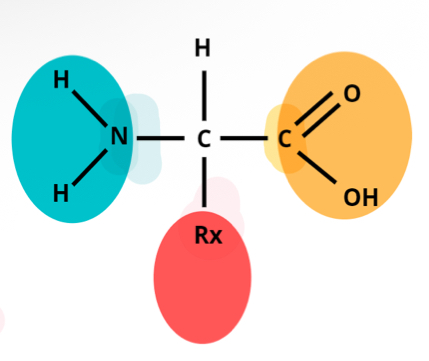
Structurally, they differ only in their __.
side chain
How many amino acids are found in nature?
500
How many essential amino acids are there? What are they?
9, essential amino acids are non-essential amino
acids that become essential when the body cannot
synthesize enough of them
How are non-essential amino acids made? What’s the process?
modifying other amino acids
– Through process of transamination
Complete vs Incomplete Proteins
Complete proteins are foods that have all nine
essential amino acids
– All animal sources are complete, as are soy, quinoa, buckwheat, hemp seeds, chia seeds, pistachios
Incomplete proteins are foods that are missing one or more essential amino acids (most commonly absent:lysine)
– Plant sources are typically incomplete
– The amino acid that is lacking is the limiting amino acid
Animal Sources of Protein
Are complete proteins
Are typically higher in total protein content
Have B (12) vitamins, iron, zinc, calcium
Tend to be lower in fiber, higher in saturated fat and cholesterol
– Increase risk of heart disease
Plant Sources of Protein
Are typically incomplete proteins (ex. Legumes —> deficient in sulfur containing amino acids, high in lysine)
Contain some B vitamins, iron, zinc, calcium
– but they are less available in the body
• These sources tend to be high in fiber, unsat fats and phytochemical
Complementing Proteins
By eating lots of plant sources of protein, all essential amino acids can be consumed = complementing proteins
– (N.B. Doesn’t have to be eaten at same meal)
multiple sources of plant proteins
Ex. Rice (limiting lysine) + beans (high in lysine)
Protein Synthesis
• To become part of a fully functional protein, amino
acids must bind together in a specific order
– Our DNA holds the instructions for the sequence of amino acids needed in order to build specific proteins
– We draw on the amino acid pool to make these
chains
Primary Structure of a Protein
The first level of protein structure arises from
adjacent amino acids binding to each other
Peptide bonds lead to the formation of a polypeptide
This polypeptide is not yet a protein
Must fold into secondary, tertiary, perhaps quaternary structure
Water released in process (condensation reaction)
Structure affects function of protein
Secondary Structure of a Protein
Hydrogen bonds between non-adjacent
amino acids lead to the formation of:
– Alpha helices (coil into, hydrogen bond between every 4th amino acids)
– Beta-pleated sheets (fold into, hydrogen bond form at stability to proteins)
Tertiary Structure of a Protein
Interactions between amino acids side chains leads to further folding of the polypeptide chain
This may result in a functional protein
3D shape: functional subunit
Hydrophilic exterior: forms binding sites
Quaternary Structure of a Protein
Some proteins have a quaternary structure
Several proteins in their tertiary structure bind together to form the final protein
Each of these is called a protein subunit
4 tertiary structure: 2 alpha helix, 2 beta sheet
Denaturation of a Protein
• A protein is denatured when it loses its folded
three-dimensional structure
– Also loses its function
• Acids, heat, agitation can all denature proteins
– This is sometimes desirable (ex. Food preparation)
Proteolysis
Breakdown of proteins into amino acids by enzymes
Protein Digestion and Absorption (Mouth, stomach, small intestine, villi)
Mouth: no enzymes that digest
Stomach: protein digestion starts (pepsinogen into pepsin)
Small intestine: most digestion occurs
Villi: further breakdown of polypeptide chains
What must happen to proteins for it to be absorbed?
The protein’s 3D structure must first be denatured
and the polypeptide must be broken down into
individual AAs to be absorbed
How are AAs absorbed?
AAs are then absorbed into the SI by active
transport (requires energy to absorb)
– Similar AAs use the same transporter
– Therefore if there is an overabundance of one AA, it may block the absorption of another!
over consume 1 amino acids: may block an of other amino acids
Ratio of amino acids:ATP - 1:1
Body Structure
Bones, muscles, skin, and every organ in the
body contain protein
Collagen is the main structural protein (28 types of—> type 1-5 is most common —> type 1 is most common)
Elastin is another key structural protein
– Permits elasticity, less strength, can be stretched 150%

Collagen Fibres in Tendon
Very stiff —> can transmit forces,
Transport
Protein tracks in cells allow substances to walk along them, permitting transport around the cell
The blood protein hemoglobin transports oxygen around the body
Protein channels & pumps regulate movement of ions and
molecules into and out of the cell
cell membranes: have protein transporters
Enzymes
Most enzymes are proteins
Recall: They speed up the rate of reactions
Allows creation of unique active sites
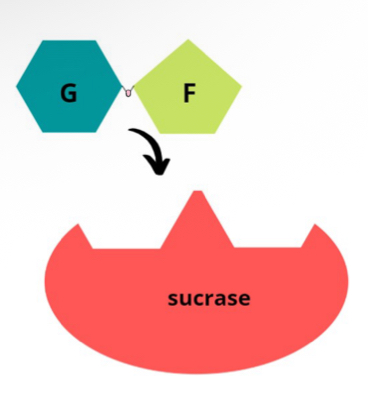
Movement
Myosin and actin are proteins found in muscle
When myosin proteins attach to actin proteins and kink their heads, muscle contraction occurs
– Allows our bodies to produce movement

Fluid Balance
Water is attracted to the positive and negative charges of the amino acids found in blood proteins
– This draws water into the blood and out of the extracellular space (controls movement)
– If blood proteins are low, fluid can build up in the extracellular space, leading to edema
Albumin: 75-80% of blood plasma (too large to leave blood….)
Protection from Disease
Collagen in skin helps to restrict what can enter the body
If infectious agents enter, proteins called antibodies (created by immune system) stick to these agents, promoting their removal and limiting the harm they can cause
they can clump together, making it easier for immune system cells to find + remove them
Our skin protects us
Energy
Protein is our last resort ( using common amino acids is wasteful)
While proteins provide 4 kcal/gram, they are a minor sources of energy to the body
It is wasteful to deaminate an amino acid so it can be
metabolized to generate ATP
– The body prefers to use protein for all its various other functions
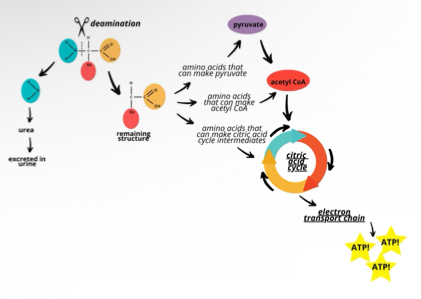
What’s the UL protein?
There isn’t one
Protein Deficiency
(Protein energy malnutrition —> lack of all nutrients)
Marasmus
– Wasting syndrome
– Occurs when energy and protein are deficient
– Promotes anemia, dehydration, heart irregularities, body temperature dysregulation
• Kwashiorkor
– Believed to occur when protein is deficient, but energy is
sufficient (eating a lot of one nutrients, incomplete)
– Evidenced by a distended, swollen abdomen and an
otherwise slim appearance
Protein and Body Weight
The primary dietary factor that promotes weight gain is a caloric intake that is consistently above the body’s needs
– Whether a high/low-protein diet leads to weight gain depends on the total calories consumed
However, protein may promote a caloric deficit by:
– Promoting fullness
– Contributing to carbohydrate and lipid metabolism
– Requiring more energy to digest and absorb it
• i.e. it has a higher thermic effect
Over consume: proteins —> fatty acids
Protein and Muscle Growth
Protein is important for the repair and growth of muscle
Protein muscle synthesis increases in the 24 hours following weight training
– 10 g of essential amino acids in the first 2 hours following exercise encourages muscle growth
– Milk-based proteins, for instance, increases muscle strength and improves body composition
Athletes have a higher overall protein requirement
– ACSM recommends increasing intake from 0.8 g/kg to 1.2-2.0 g/kg, depending on the intensity and load of training (strength/power: 1.6-1.7, endurance:1.1-1.4?)
eat protein to make protein
Consume protein right after exercise
How many grams of protein can the body handle at a time?
30
Protein and Bone Health
• In bone, collagen forms a matrix that minerals (ex.
Calcium) harden
• However, high protein diets can promote calcium excretion
• Overall, high protein diets do not seem to negatively affect
bone health
Protein metabolism: increased carbon load?
Protein and Kidney Health
High protein diets tax the kidneys because they have
more waste products to excrete
For those with reduced kidney function, consuming protein at the recommended intake level (0.8 g/kg), and not beyond it, is recommended
Increased protein consumption: no negative impact on kidneys
Protein Quality
Typically refers to two factors:
– How well a protein is digested
– How the types and quantities of amino acids in that protein
source match the body’s requirements (what it makes compared to what we need)
Ways to Assess Protein Quality
Protein digestibility corrected amino acid score (PDCAAS)
– Compares the amino acid content of a food against a standard amino acid profile, the highest score that can be achieved is 1.0 (Based on rats —> rat feces: what’s left of protein/not digested into rat)
– Takes into account the digestibility of the protein
– This is the industry standard
Digestible indispensable amino acid score (DIAAS)
– Measures how well amino acids are digested in the ileum and more closely estimates the amount of amino acids absorbed by the body
– Database is still being built
Protein efficiency ratio (PER)
– How much weight an animal gains when consuming a specific amount of protein, divided by the amount of food it consumed
– Used in Canada
animal PDCAAS sources: 90-91% or 0.90-0.91
Plant: legumes - 0.5-0.6, soy - 0.65-0.75
Protein Supplements
Protein supplementation can be from whole sources and from protein supplements (ex. Protein powders, shakes)
Strength and muscle size increases with protein supplementation, especially in younger people who train regularly
– However, excessive supplementation (>1.62 g/kg body weight) does not promote further gains
– Doesn’t have to come from supplements!
NOVA group 4
Easy access to protein
Protein powders: not regulated by government —> some have substances not listed on label
Branched-Chain Amino Acids
BCAAs are essential amino acids that have a branched side chain
They account for 35-40% of the dietary essential amino acids found in body protein
Have been shown to reduce muscle damage associated with weight training
Can be consumed from whole sources, do not have to come from supplements!
All side chains are more branched
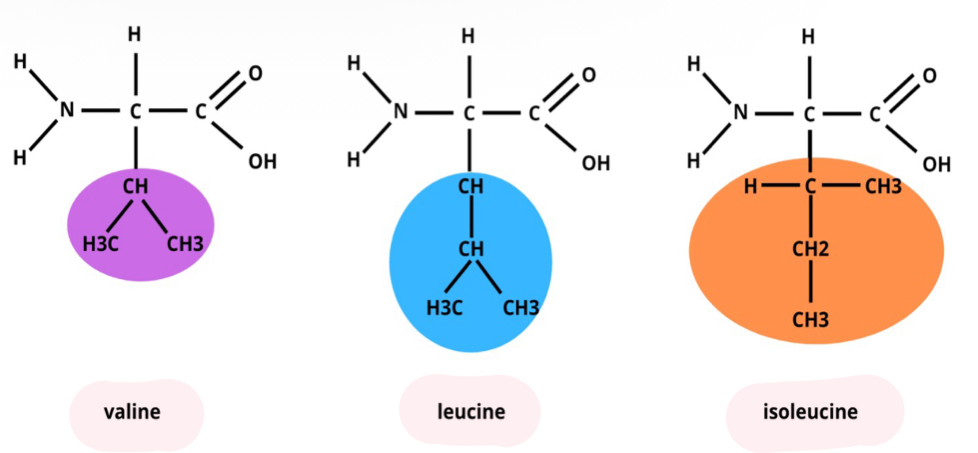
Animal Sources of Protein
Animal proteins have more total protein, a higher PDCAAS and are complete proteins (more easily digested)
Also, they have vitamin B12 and are higher in vitamin D, iron, zinc, and omega-3 fatty acids
However, they are also higher in saturated fat and are
absent in fibre, phytochemicals
Also, processed animal products (ex. Deli meats, bacon)
increase CVD risk/mortality
Consuming animal products has a significant __ impact.
Environmental. Grown + cultivated for consumption
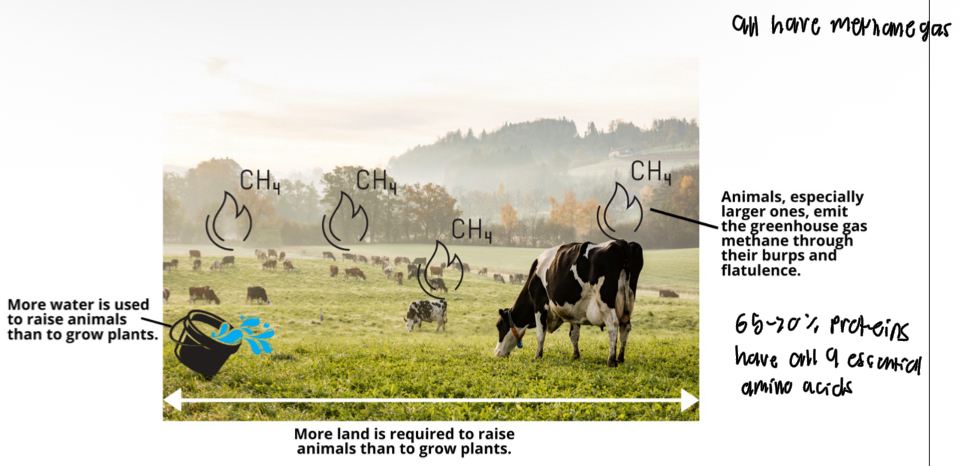
Omnivore
A person who consumes a variety of both animal and plant products
Semi-vegetarian
A person who restricts one or more type of animal product. For instance, a semi vegetarian might avoid all red meat.
Pescatarian
A person who restricts most or all animal products except fish.
Plant-based diet
A diet that is mostly or entirely based on plant-derived foods and ingredients. However, there is no clear definition of this term. Vegetarian and vegan diets are plant based.
Vegetarian
A person who avoids some or all animal-related food and ingredients.
Lacto-ovo vegetarian
A person who avoids animal flesh, but consumes milk products (lacto) and eggs (ovo).
Lacto-vegetarian
A person who avoids animal flesh and eggs, but consumes milk products.
Vegan
A person who excludes all animal products, including eggs and milk. This may also include any animal-involved products, such as honey.
Health Benefits of Vegetarian Diets
Diets are high in fibre and phytochemicals and low in
saturated fats
Vegetarians are more likely to have lower BMIs, total cholesterol and LDL
They are also at lower risk for heart disease, cancer, and CVD mortality
Lower body mass index (epidemiological studies)
Risks of Vegetarian Diets
They are lower in vitamin D, omega-3 fatty acids, calcium, iron, and zinc
Vitamin B12 is only found in animal products (with the exception of nutritional yeast)
Supplementation is recommended if these are not sufficient in diet
Balancing Protein Intake and Losses
By measuring nitrogen intake in the diet (ie. By measuring protein intake), and nitrogen output in the urine, you can assess whether someone is in a state of negative nitrogen balance (net protein breakdown), positive nitrogen balance (net protein deposition) or nitrogen balance (protein content of body remains the same)
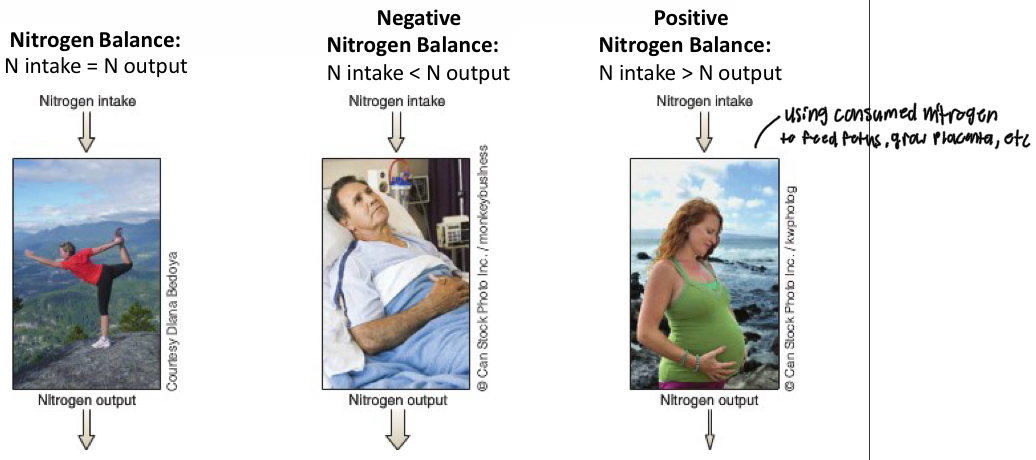
Consume most protein from __ sources
Whole
Name plant and unprocessed animal proteins that satisfy protein needs while promoting health.
plant proteins: nuts, beans, and legumes
unprocessed animal products: fish and lean meats
Based on body weight, what’s the protein recommendation per day for those 19 years of age and older?
0.8 g/kg body weight
Why do children and infants have higher protein requirements?
To support their growth and development
Soft tissue development
DRI of protein needs for pregnant and lactating women
Pregnant women: 1.1 g/kg body weight
Lactating women: 1.3 g/kg body weight